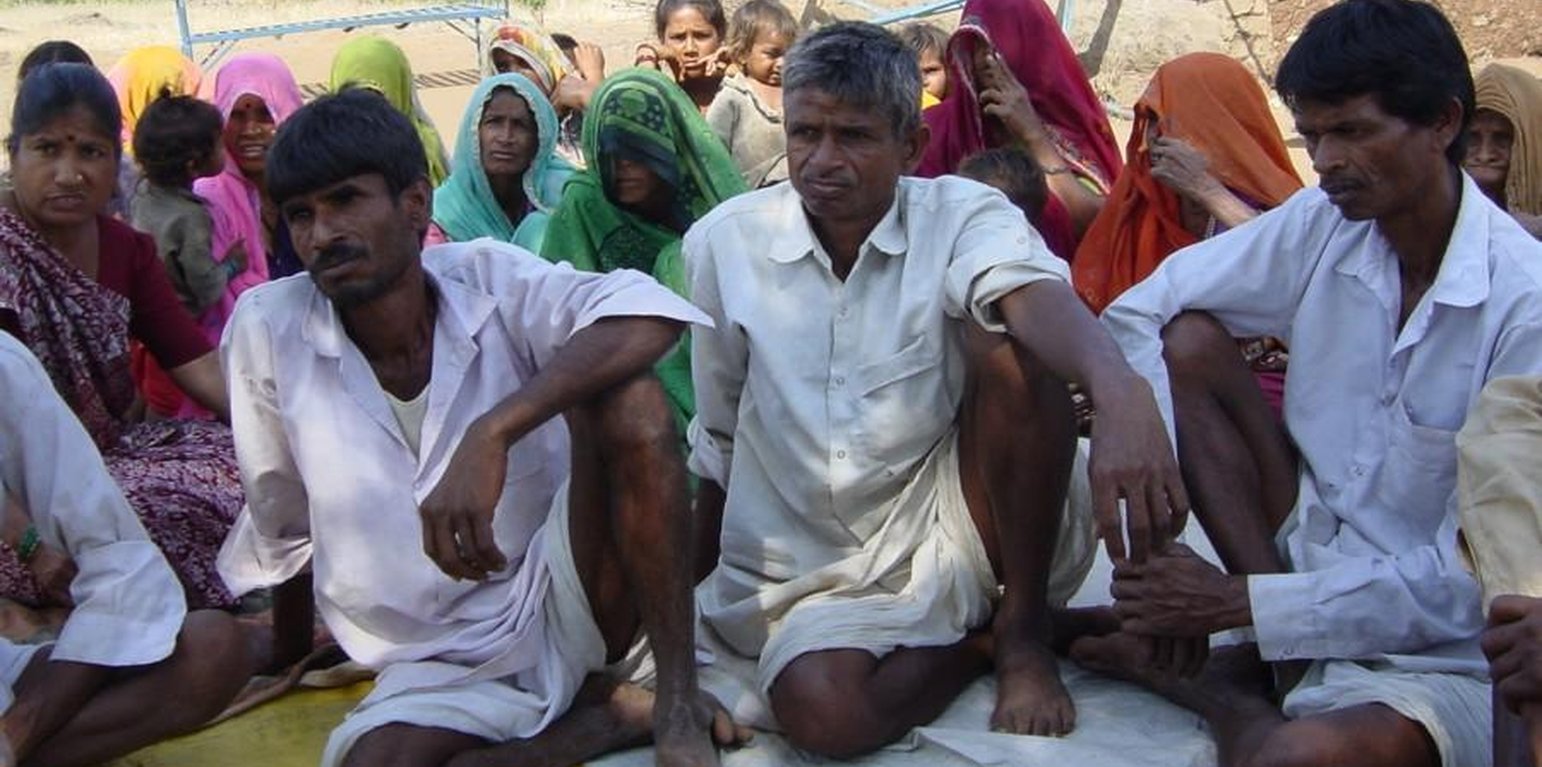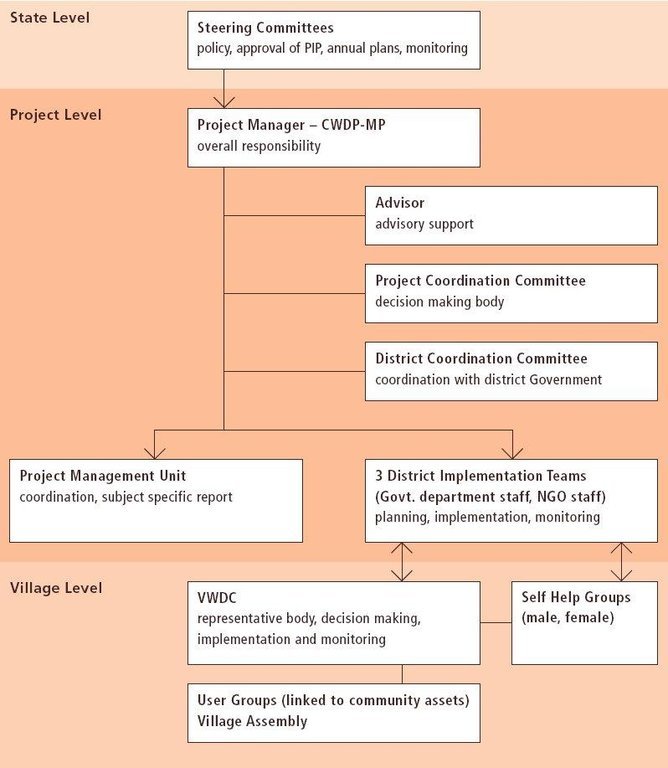Comprehensive watershed development
(India)
Description
Participatory approach that includes a package of measures leading to empowerment of communities to implement and sustain watershed development.
Aims / objectives: The approach adopted under the Comprehensive Watershed Development Project (CWDP) is intended to ensure sustainability of development interventions. This can only be achieved through creating a sense of 'ownership' amongst users, which means involving the community in planning, implementation and management of the interventions. A further, specific objective is to benefit vulnerable sections of the community.
Methods: Various methods are employed to achieve these goals. There is, first of all, awareness generation within the community through exposure visits outside the area, street theatre and video shows. After this comes the formation and capacity building of village level institutions, in particular the Village Watershed Development Committees (VWDCs). Users' groups are also formed. Micro-planning (under a 'village development plan') using participatory rural appraisal (PRA) follows. There are arrangements to ensure participatory execution of the plan, specifying cost and benefit sharing (on average 75%-90% of the work is paid for in cash under this approach). Another important element is to ensure user rights to resources. This entails negotiation with government for rights to produce from common land. Eventually, after initial implementation, management becomes the task of the users' groups: this includes maintenance, distribution of benefits and conflict resolution. The whole process involves NGOs along with government staff in order to achieve better communication all round. The participants have different roles. Government staff (at various levels) provides technical and financial support, as well as assistance towards gaining user rights over resources. NGOs are particularly important in awareness generation and mobilisation, capacity building of village level institutions, and in the process of negotiation with the Government.
Role of stakeholders: The village committee is central in planning and implementation of the village development plan, and in overseeing users's groups. Users's groups are involved in planning, implementation and then resource management. The village assembly helps to identify beneficiaries and users, and to give overall support to the VWDC. An external international donor, DANIDA of Denmark, supports the Comprehensive Watershed Development Project.
Location
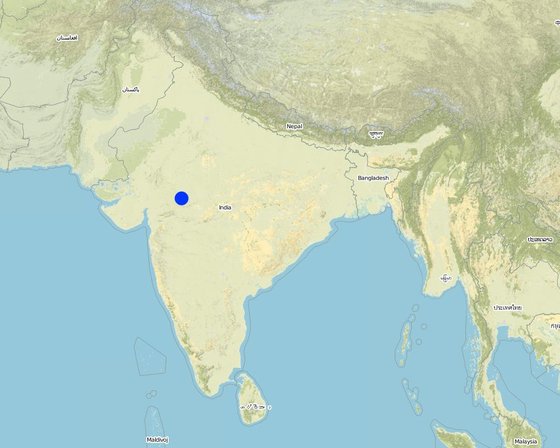
Location: Madhya Pradesh, India
Geo-reference of selected sites
Initiation date: 1997
Year of termination: 2007
Type of Approach
-
traditional/ indigenous
-
recent local initiative/ innovative
-
project/ programme based
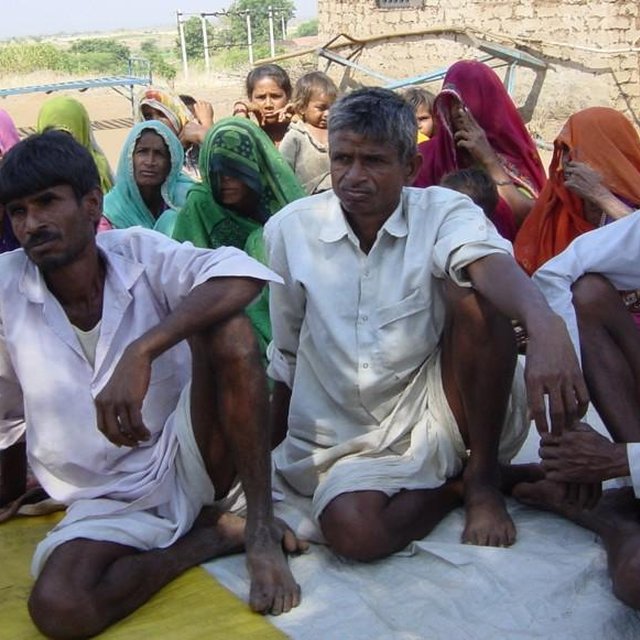
.
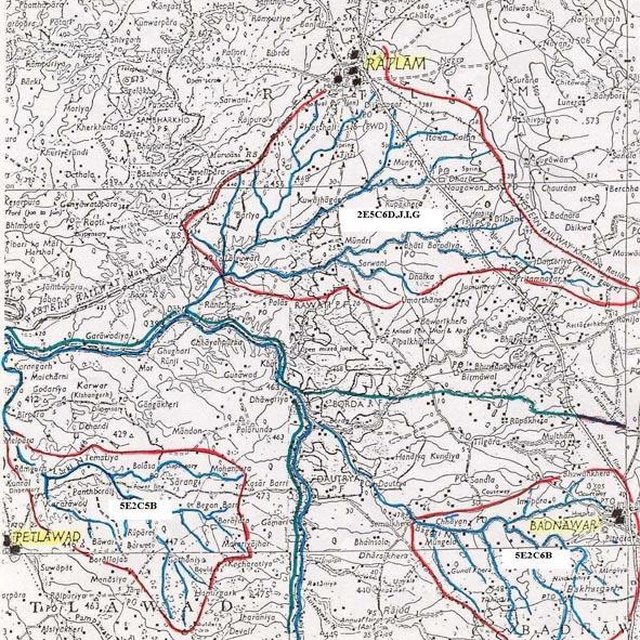
Map of DANIDA CWDP-MP.
Approach aims and enabling environment
Main aims / objectives of the approach
The Approach focused mainly on SLM with other activities (1- Capacity building of communities, 2- Production system)
- create a sense of ownership amongst users. - ensure sustainability of technical and social interventions. - benefit more vulnerable sections of the community, including the poor and women. - involve the community in planning, implementation and management interventions
The SLM Approach addressed the following problems: previous lack of consultation/involvement with the community in planning, implementation and management of watershed development interventions
Conditions enabling the implementation of the Technology/ ies applied under the Approach
Conditions hindering the implementation of the Technology/ ies applied under the Approach
-
Social/ cultural/ religious norms and values: Lack of awareness and mobilisationon improvement of production systems.
Treatment through the SLM Approach: Intensive programme for awareness generation and mobilisation of community
-
Availability/ access to financial resources and services:
Treatment through the SLM Approach:
-
Institutional setting: Lack of effective institutions at village level to take responsibility for the development process.
Treatment through the SLM Approach: Formation & capacity building of VLI (VWDC,UG) with assistance of NGOs.
-
Legal framework (land tenure, land and water use rights): Uncertainity fover rights to access to resources
Treatment through the SLM Approach: Negotiations facilitated by NGOs
The existing land ownership, land use rights / water rights moderately hindered the approach implementation While treatment of privately owned land did not face a problem, encroachment on Govt. land was an obstacle which discouraged land users from implementing SWC on these lands. Furthermore it was not possible to obtain users rights on lands under the Forest Department, which resulted in their exclusion from SWC in most cases. The NGOs involved however acted as intermediaries in negotiations.
-
Knowledge about SLM, access to technical support: High cost water harvesting measures.
Treatment through the SLM Approach: Demonstration of low cost alternatives such as the doh (sunken structure in dry riverbed to increase infiltration of runoff, which replenishes wells for irrigation: see 'related technology').
Participation and roles of stakeholders involved
Stakeholders involved in the Approach and their roles
| What stakeholders / implementing bodies were involved in the Approach? |
Specify stakeholders |
Describe roles of stakeholders |
| local land users/ local communities |
Specific ethnic groups: While the main group were Bhil tribal, other groups included Gujars, Patidars etc. |
Due to social factors, traditionally decision making largely done by men. However, the project has worked towards involving women in all aspects of the project. Participation of women in decision making bodies such as village committee is restricted . Participation of women is good in implementation, self-help groups etc. The project is active in neediest & most degraded villages which are fairly homogenous in nature. Furtherore efforts are made to identify and benefit poorest households. |
| NGO |
|
|
| local government |
Village Watershed Development Committee, Users Group. |
|
| national government (planners, decision-makers) |
Govt. of India/ Govt. of Madhya Pradesh, Department of Agriculture. |
|
| international organization |
Danida |
|
Lead agency
The broad approach was developed by national and international specialists at the time of project appraisal. The detailed pedagogy was developed by the project in consultation with NGO partners and consultants.
Involvement of local land users/ local communities in the different phases of the Approach
none
passive
external support
interactive
self-mobilization
initiation/ motivation
Mainly:public meetings; partly: awareness generation; Community meeting for discussion. Street plays, exposure visits for awareness generation.
planning
Mainly: rapid/participatory rural appraisal; partly: group meeting; Preparation of village plan. Discussion on village plan. Negotiation, Decision making.
implementation
responsibility for minor steps; Landusers provide labour, partly subsidized by project. VWDC members involved in supervision & payments.
monitoring/ evaluation
measurements/observations; Water levels, migration rates monitored by community with project staff. Gram sabha (Village assembly) meets every 3-6 months to discuss project activity. VWDC meets monthly to take stock.
Research
on-farm; studies carried out by project staff.
Flow chart
CWDP-MP: Comprehensive Watershed Development Project in Madhya Pradesh PIP: Project Implementation Plan VWDC: Village Watershed Development Committee
Decision-making on the selection of SLM Technology
Decisions were taken by
-
land users alone (self-initiative)
-
mainly land users, supported by SLM specialists
-
all relevant actors, as part of a participatory approach
-
mainly SLM specialists, following consultation with land users
-
SLM specialists alone
-
politicians/ leaders
Decisions were made based on
-
evaluation of well-documented SLM knowledge (evidence-based decision-making)
-
research findings
-
personal experience and opinions (undocumented)
Technical support, capacity building, and knowledge management
The following activities or services have been part of the approach
-
Capacity building/ training
-
Advisory service
-
Institution strengthening (organizational development)
-
Monitoring and evaluation
-
Research
Capacity building/ training
Training was provided to the following stakeholders
-
land users
-
field staff/ advisers
-
SWC specialists, extensionists/trainers
Form of training
-
on-the-job
-
farmer-to-farmer
-
demonstration areas
-
public meetings
-
courses
-
exposure visits
Subjects covered
1- Training for VWDC, UG, SHG's to conduct meetings, accounts and book-keeping. 2- Technical trainings. These are provided by government and NGO staff. Training concentrates on participatory approaches and low cost technologies. Capacity building for community groups and land users enables them to participate better in projects and to take ownership of assets.
Advisory service
Advisory service was provided
-
on land users' fields
-
at permanent centres
Name of method used for advisory service: Multi Disciplinary Teams; Key elements: Field staff drawn from different Govt. line deptt. and NGO's., Village level workers selected locally, paid by the Project through NGOs., Formation, capacity building of village level institutions and farmers.; 1) Advisory service carried out through: non-governmental agency, projects own extension structure and agents; Extension staff: Govt.+ NGO employees 2) Target groups for extension: land users; Activities: Capacity building of village institutions, demonstration of SWC measures, production
Advisory service is quite adequate to ensure the continuation of land conservation activities; The state policies now emphasise the participatory approach. However, aspects like GO-NGO cooperation need to be instutionalised.
Institution strengthening
Institutions have been strengthened / established
-
no
-
yes, a little
-
yes, moderately
-
yes, greatly
Describe institution, roles and responsibilities, members, etc.
Type of support
-
financial
-
capacity building/ training
-
equipment
Further details
Monitoring and evaluation
bio-physical aspects were regular monitored through observations; indicators: general parameters
technical aspects were regular monitored through measurements; indicators: water levels in some wells
socio-cultural aspects were ad hoc monitored through measurements; indicators: migration
economic / production aspects were regular monitored through measurements; indicators: yield
area treated aspects were ad hoc monitored through observations; indicators: hectares treated
no. of land users involved aspects were regular monitored through measurements; indicators: attendance at meetings
There were several changes in the Approach as a result of monitoring and evaluation: Several technological changes have taken place as a result of a review: for example feedback on yield data led to crop variety recommendations. Levels of water in wells confirmed impact of the 'sunken structures' (dohs).
Financing and external material support
Annual budget in USD for the SLM component
-
< 2,000
-
2,000-10,000
-
10,000-100,000
-
100,000-1,000,000
-
> 1,000,000
Precise annual budget: n.a.
Approach costs were met by the following donors: government (national): 5.0%; international (-): 85.0%; local community / land user(s) (labour): 10.0%
The following services or incentives have been provided to land users
-
Financial/ material support provided to land users
-
Subsidies for specific inputs
-
Credit
-
Other incentives or instruments
Financial/ material support provided to land users
partly financed
fully financed
Labour by land users was
-
voluntary
-
food-for-work
-
paid in cash
-
rewarded with other material support
Impact analysis and concluding statements
Impacts of the Approach
No
Yes, little
Yes, moderately
Yes, greatly
Did the Approach help land users to implement and maintain SLM Technologies?
The participatory approach has been fairly successful in demonstrating SWC technologies such as Silvi Pasture, Sunken Structures which have been adopted/maintained by the land users.
Did the Approach improve issues of land tenure/ user rights that hindered implementation of SLM Technologies?
By using the approach, the project was able to win the confidence of most land users.
Did other land users / projects adopt the Approach?
The pilot project which has tested the approach over past 3-4 years is implemented by the Department of Agriculture. The State Department of Agriculture has now expanded the approach to its other projects eg. NWDPRA.
Main motivation of land users to implement SLM
Sustainability of Approach activities
Can the land users sustain what hat been implemented through the Approach (without external support)?
Conclusions and lessons learnt
Strengths: land user's view
-
Awareness about SWC increased through street plays, exposure visits. Use of drama preferred to verbal communication. (How to sustain/ enhance this strength: Continue, and include visits to successful income generating projects.)
-
Participatory planning has led to better understanding of resources and possibilities (How to sustain/ enhance this strength: The entire village plan should be implemented in defined stages to allow impact to be noted/felt.)
-
Cost-sharing increases feeling of ownership. (How to sustain/ enhance this strength: Community contribution should be deposited in the village fund to enable further activities after project moves out.)
-
Due to village institutions, there is greater decentralisation of ressponsibility and more people are actively involved.
-
As a result of village fund, interest component remains within the village.
-
Increased transparency as a result of GO-NGO cooperation. (How to sustain/ enhance this strength: Less rigidity in roles of GO/NGO staff.)
Strengths: compiler’s or other key resource person’s view
-
Marginalised groups have been identified and given a 'say' (How to sustain/ enhance this strength: NGOs should continue to advise/guide/monitor activities)
-
Systematic approach to strengthen community participation (How to sustain/ enhance this strength: Detailed 'process documentation' to be continued.)
-
Leadership developed at village level. (How to sustain/ enhance this strength: NGO's continue to advise/guide/monitor activities in the village.)
-
Land users develop a strong sense of ownership of the assets created. (in terms of cost-sharing, a local contribution of up to 25% is high in Indian contexts) (How to sustain/ enhance this strength: There needs to be continued support for 2-3 years after phasing out of bio-physical watershed development activities; also important to build up village funds through a 'community contribution' charge deducted from wages.)
-
Government system can be strengthened by co-operation with NGOs in watershed management projects (How to sustain/ enhance this strength: Continue dialogue between partners at various levels..)
Weaknesses/ disadvantages/ risks: land user's viewhow to overcome
-
Formation of User group creates conflict with surrounding villages.
-
Segregation of responsibilities of GO-NGO staff viz. NGO role restricted to community organisation while GO staff deal with technical asspects.
Better integrated teamwork should be the goal.
-
A 'community contribution' charge is currently deducted equally from all villagers by the project from wages paid
Contribution to be deposited in village fund., Should be a greater voluntary contribution from the richer farmers.
-
Participation in various meetings at village level is cumbersome for women, resulting in increased pressure from male family members and loss of wages.
-
Project duration for planning and implementation too short
Increase the timespan to 3 years or more.
-
Women not adequately involved in exposure visits.
Correct this imbalance/arrange separate visits for women.
-
Exploitation by middlemen when small farmers market produce not addressed by the project.
Group marketing of produce.
Weaknesses/ disadvantages/ risks: compiler’s or other key resource person’s viewhow to overcome
-
Because of low literacy levels NGO support to village level institutions is required for more than just short-term
Adult literacy classes of sufficient duration are needed.
-
PRA brings out many social factors that are beyond the scope of the project to influence eg the feudal system
NGOs need to have broadbased activity platforms that can address these issues as they arise.
-
Shortage of female staff restricts contact with women land users.
Gender sensitization, training for project staff intensified.
References
Reviewer
-
Fabian Ottiger
-
Deborah Niggli
Date of documentation: Jan. 21, 2009
Last update: April 4, 2018
Resource persons
-
David Gandhi (david_gandhi@yahoo.com) - SLM specialist
-
Prakhar Bhargava (pmdrtm+changeme2@sancharnet.in) - SLM specialist
-
Devendra Patankar (pmdrtm+changeme1@sancharnet.in) - SLM specialist
-
R.D. Khare (pmdrtm@sancharnet.in) - SLM specialist
-
Nilesh Desai - SLM specialist
-
M.I. Khimla (nlc_rlm1+changeme@epatra.com) - SLM specialist
-
Nayak Trilochan (danidain@mantrafreenet.com) - SLM specialist
-
Tapan Bhattacharya - SLM specialist
Full description in the WOCAT database
Documentation was faciliated by
Institution
- Danida assisted Karnataka Watershed Development Project, Bijapur (Danida assisted Karnataka Watershed Development Project, Bijapur) - India
- Lok Biradari Trust - India
Project
- Book project: where the land is greener - Case Studies and Analysis of Soil and Water Conservation Initiatives Worldwide (where the land is greener)
Key references
-
'Participatory approaches in watershed management- successful experinces' David Gandhi 2002: Indian Association of Soil Conservation, Central Soil & Water Conservation Research & Training Insti
